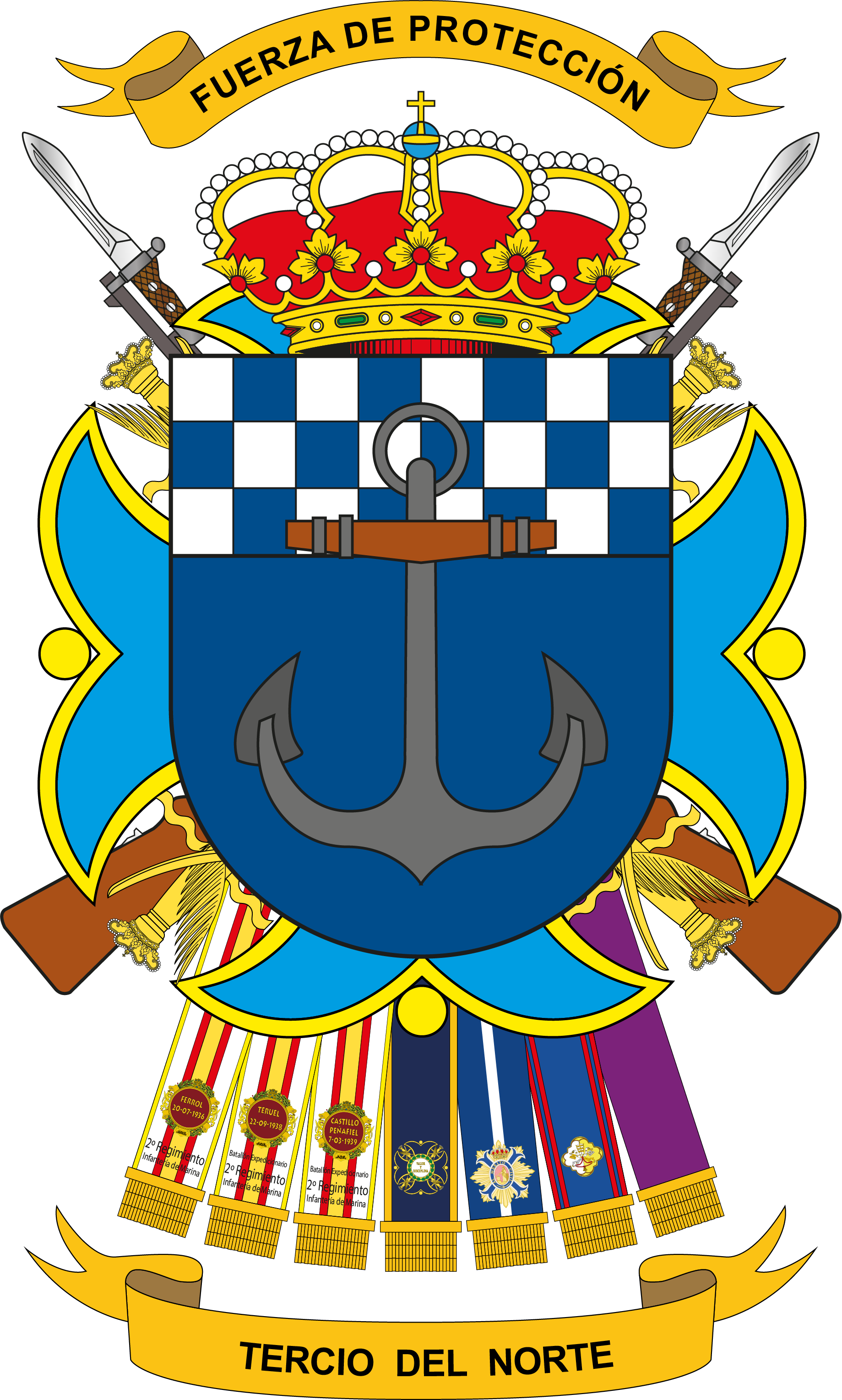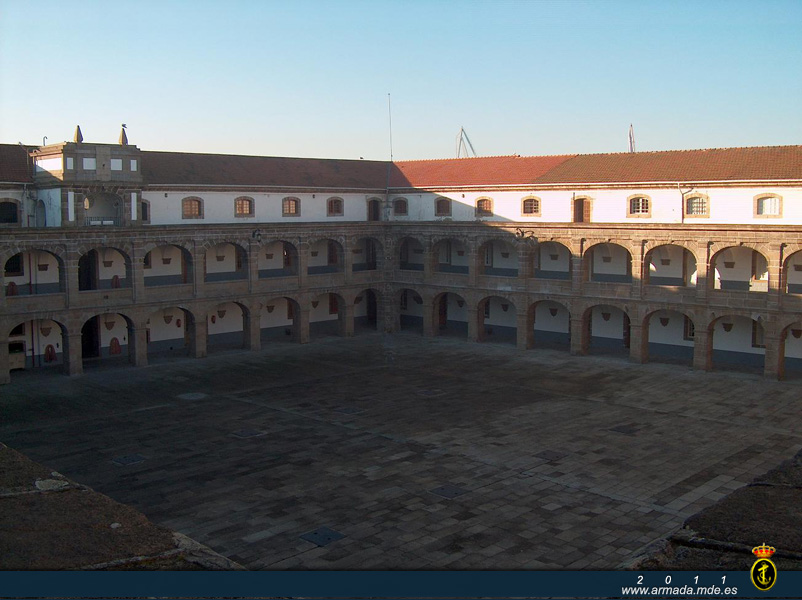Northern Regiment (TERNOR)
Marine Corps
Welcome to the "Tercio del Norte" (Northern Regiment) website. The Home Base of this Marine Corps Unit is the "Nuestra Señora de los Dolores" Headquarters, a 1771 building in the outskirts of Ferrol (Corunna).
From then until now, TERNOR Marines have taken part in most Spanish conflicts: the Peninsular War against the Napoleonic Army; the defense of our overseas colonies in Cuba and the Philippines; participation in the African War and many other campaigns.
The Northern Tercio is entrusted with the protection and security of all naval facilities in the Northern part of Spain, from France to Portugal. Although this is our main task, we also take part in specific Marine Corps missions.
The regiment is located in the north-western city of Ferrol; and more in particular at the "Nuestra Señora de los Dolores" Headquarters since 1771. It is arguably the only Spanish barracks with more than 230 year of uninterrupted service.
The current workforce of the Northern Tercio is 488: 22 officers, 42 NCOs and 422 soldiers under the command of a MC Colonel. Unit members are not only Marines; some of them come from other Corps (Medical) and Specialties (mechanics, electricians, administration, catering). There is also a group of civilian personnel.
Command
The command is exercised by a Marine Corps Colonel assisted by a Lieutenant-Colonel and his Staff (Operations, Personnel, Intelligence, Logistics, Medical Service, and Quartermaster Corps).
Security Company
This unit is tasked with the security of Spanish Navy personnel and facilities providing escorts, patrols, detachments or surveillance. To this end, there are two Security Platoons and two Operational Squads.
- Security Platoons: hey are the main Company elements, with the typical structure of a Rifle Platoon. Apart from providing security to La Grańa Naval Base, Mougá magazines, San Sebastián Command Headquarters, etc.), the platoons organize military convoys escort, mainly of weapons and ammunition.
- Operational Squads: They are well trained units in charge of special operations tasks such as qualified escorts, special security measures and rapid reaction force in special alert situations.
Craft Platoon
It is in charge of maintaining the RHIBs (rigid-hulled, inflatable boats) and other craft ready for any mission which may arise. Members of this platoon attend skipper courses at La Graña Maneuver School.
Naval Police Company
This Company has three Platoons: Naval Police platoon, Escort platoon, Dog Unit.
- Naval Police Platoon: To become a naval police officer you must attend a 7-week course in Cartagena (Murcia). Mission:
- Surveillance:Monitor the behavior and discipline of military personnel while out of base.
- Transfer and custody of prisoners and classified information. Implementation of security measures in military events.
- Assist the military police of the other Services, and protect military tribunals..
- Surveillance and control of naval centers and facilities
- Manage traffic within military grounds and collaborate with local police during military events or celebrations.
- Escort Platoon: It is made up of Naval Police officers with VIP protection qualification. They provide protection to military authorities and also to civilian authorities visiting naval facilities.
- Dog Unit: This unit has now 11 skilled police dogs tasked with different missions, particularly drug and explosive detection. The dogs are trained to find specific scents in 5-month courses organized by the Defense Dog School and the Civil Guard Dog Unit.
Staff and Services Company
As it name suggests it provides different services to other companies. It has three platoons:
- Transport platoon: It provides the necessary vehicles and drivers for the daily activities or scheduled exercises. It has light and heavy all-terrain vehicles and trailers (fuel, fresh water, mobile kitchens).
- Communications platoon.
- Service platoon:Responsible for all necessary services: kitchens, larder, administration, cleaning, storerooms, arsenals, etc.
Music Company
The Music Company was founded in 1855. It is tasked with entertaining armed forces celebrations with military music. It also participates in different civilian ceremonies like hoisting and lowering of flags, Holy Week celebrations, concerts in schools and associations, etc.
The Northern Tercio is part of the Protection Force, and therefore, its mission is to provide security and protection to Spanish Navy personnel and facilities from the Bidasoa river in the Spanish-French border, to the Miño river in the Portuguese border. The Unit is always in full readiness and capable of responding to any possible assault.
In the 21st Century, the men and women who make up the Tercio del Norte continue providing protection to ships, centers and facilities with the same enthusiasm. It has not been difficult for this institution with so many years of history to change with the times. A new functional structure, modern technologies and sophisticated electronic equipment help the Tercio to be always ready and operational. Constant physical training and shooting drills in the firing range also contribute to have perfectly fit Marines.
Weapons: 5.56x45mm HECKLER & KOCH assault rifles; HK G36KV-S1 rifles with laser designator AN/PQ-2A; HK AG36 grenade launchers; MOSSBERG 500 shotguns; tear-gas guns; 7.62x51mm AW accuracy rifles; 9mm FNH pistols; 7.62x51 and 5.56x45 MINIMI machineguns, and AN/PVS-14 night vision goggles.
The Unit has also a wide assortment of anti-riot equipment: TAC-009 body protectors, helmets, gas masks, shields and FE-DG1 defenses.
Communications: short, medium and long wave sets.
Vehicles: Nissan PATROL and PATHFINDER, Land Rover DEFENDER, police cars, an ICU ambulance and Pegaso/IVECO 4x4 lorries.
Unit craft include Zodiac F470 COMANDO and VALIANT for coastal and river deployments, and boarding exercises.
Since 2004, the Northern Tercio has participated in the following operations:
- Surveillance and protection operations of State infrastructures during the March 2008 General Elections (CENTINELA ELEGIDO) in the Galician region and the Zaragoza International Exhibition in the summer 2008 (CENTINELA ARAGONÉS) protecting some sections of the High Speed Railway.
- Operation CENTINELA GALLEGO (Forest fires contingency program) in collaboration with the Galician Regional Government (2006 - 2011).
- Several security operations on board Spanish Navy ships. For example, the rescue operation of Spanish trawler "Playa de Bakio" in Somali waters in April 2008, operation ALLIED PROTECTOR (Feb-Jul 2009); operation ACTIVE ENDEAVOUR, operation ATALANTA (Nov 2010-Mar 2011) and operation UNIFIED PROTECTOR (Mar-Jul 2011).
- Peace-keeping operation ALTHEA in Bosnia-Herzegovina in 2008 and 2009.
- Operation LIBRE HIDALGO in the Lebanon (2011) with a Dog Unit (Explosive detection).
As has already been said, the Northern Tercio established its base at the "Nuestra Señora de los Dolores" Headquarters in 1771.
Since then, they have participated in most conflicts starting in August 1800, when a British Flotilla with 15,000 men landed in Doniños to destroy the Spanish Northern fleet and arsenals. A Marine Corps battalion under the command of Juan Doval repelled the attack with just over 2,000 men and forced the British troops to retreat.
Years later, this time with British forces as allies, Ferrol MC battalions fought in the Peninsular War against the French. Under the command of Colonel Blake, three battalions (2,300 men) participated in numerous battles in cities like Medina de Rioseco, Espinosa de los Monteros, Ponferrada, Puebla de Trives, etc. From 1811 until 1813, they battled in different theatres until they reached the Bidasoa river. The Ferrol Marine Corps battalions were the first Spanish troops to enter French territory in pursuit of retreating Napoleonic troops. The six-year campaign ended with the seizure of Toulouse on April 10th. The King awarded the Marine Corps battalion the "Tolosa Blue Sash". Since then, its coat of arms includes the motto: "Valor y disciplina" (Courage and Discipline).
The Chief of the joint Spanish-British forces, Lord Wellington, praised the courage and bravery of Galician Troops during the campaign, encouraging Spanish troops to follow the steps of the "inimitable Galicians".
During the 1834 Carlist War, the first Navy forces to defend the throne of Queen Isabella II were the Ferrol battalions. In 1849, elements from the Northern Tercio embarked in Barcelona, along with other Spanish troops, in an expedition to restore pope Pious XI to the throne of the Holy See in Rome. For this crusade, the Unit's flag was awarded the "Papal White Sash".
In the 19th Century, Marine Corps forces served in the Spanish colonies of Africa, Cuba and the Philippines. It is precisely in Cuba where two Marines from the 2nd Regiment of the 2nd Battalion -privates José Rama and Antonio Cancela- heroically participated in a glorious episode.
On June 5th 1895, a detachment with a corporal and twelve soldiers was defending the railway from Gíbara to Holguín (Cuba), when hundreds of insurgents attacked the unit. All soldiers died in the skirmish except Rama and Cancela who, without ammunition and with just bayonets, defended the post until reinforcements arrived. But by then, they had already perished under enemy fire.
They were posthumously awarded the highest Spanish decoration, the "Cruz Laureada de San Fernando" and commemorative plaques were placed in all Marine Corps Headquarters.
During the Spanish Civil War, another Galician soldier became a hero on board the cruiser "Baleares". In the middle of a naval combat, Manuel Lois Garcí>a, stationed at gun Num 4 as telephone operator, took an illuminating bombshell with his bare hands and threw it overboard. This action prevented the loss of hundreds of lives, but the soldier died that very night as a consequence of the burns. He was awarded the "Cruz Laureada de San Fernando" and buried at the Illustrious Sailors Vault in San Fernando. In 1965, the remains of Manuel Lois are moved to his birth place, Órdenes, escorted by a Northern Tercio unit. Every November 1st a TERNOR component visits his tomb and pays tribute to this illustrious man.
Apart from the Tolosa and Papal sashes already mentioned, the TERNOR flag has other decorations like the "Purple Sash" (Royal House) and three Military Medals for the battles of Ferrol, Teruel and the amphibious landing in Cartagena during the Spanish Civil War.
There is a glass case at the TERNOR Colonel's office showing the damaged Battle Ensign of the 2nd Battalion of the 2nd Regiment which took part in the following campaigns:
- Santo Domingo campaign.
- Carlist War.
- Cuban campaign.
- The Philippines campaign.
- African campaign.
In 1951 the Northern Tercio set up the "Amphibious Climbers Company". In 1957 the company was transferred to the Southern Tercio and became the germ of the future "Special Operations Unit".




 + 3
+ 3



